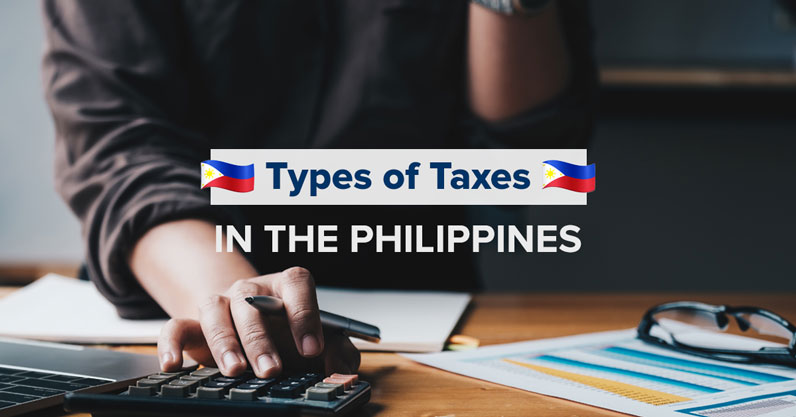Types Of Taxes In The Philippines
4 min readThey say only two things are certain in life: Death and taxes. Quite ironically, we won’t live if we don’t pay our taxes—it’s just part of how society functions.
But how much do you know about taxes? Learning each one by heart may a lifetime, but for basic knowledge on the different types of taxes in the Philippines, here’s a cheat sheet.

Philippine national taxesÂ
National taxes are mandatory contributions imposed by the government and collected through the Bureau of Internal Revenue (BIR), which is grounded on the Republic Act 8424, or National Internal Revenue Code of 1997, and known as Tax Reform Act of 1997. Export and import tariffs are also referred to as national taxes but these are levied by the Bureau of Customs (BOC) and will be excluded from this list.
1. Estate TaxÂ
Estate tax is charged to your estate or properties when the titleholder meets their demise. At a rate of 6%, the heir apparent or the rightful beneficiary of the estate should settle this tax before transferring the title to the heir or beneficiary’s name.
2. Documentary Stamp TaxÂ
This refers to the tax imposed on contracts, loan agreements, certificates, and other legal papers that serve as proof of transfer/sale of an ownership/obligation of a property or assets.
3. Percentage TaxÂ
Percentage tax is a business tax imposed on merchants or businesses that lease/sell products, services, and properties. They are not VAT-registered, with a yearly gross sale at a maximum of P750,000.
4. Capital Gains TaxÂ
Capital Gains tax refers to what an individual or a business pays upon making profits out of selling a valuable asset. These sold assets subjected to capital gains are pieces of jewelry, stocks, properties, and other goods appraised with high value.
5. Income TaxÂ
This refers to the tax that is imposed on an individual’s earnings, be it salary or profits, from his/her profession, business, trade, or properties at rates ranging from 5% to 32% depending on their income bracket.
6. Withholding TaxÂ
Withholding tax is the amount from an employee’s wage deducted by the employer and directly paid to the government for the employee’s partial income tax.Â
7. Value-Added Tax or VATÂ
Value-Added Tax serves as a consumption fee that is placed on a product when there is an additional value to its manufacturing and final sale. Since it is considered an indirect tax, the customers pay for VAT.
8. Excise TaxÂ
Excise Tax is placed on products sold in the country and considered an indirect type of tax because this can be recovered by the seller/producer by increasing the price of these products. This is emphasized in the TRAIN law. Example placement of an excise tax can be cited from the products with health risks such as liquors and tobacco.Â
(Read: Enhanced PhilHealth Benefits Packages For COVID-19 Patients)
9. Donor’s TaxÂ
Donor’s Tax is placed on a gift, donation, or willful free-of-charge transfer of property between the benefactor to recipients on their lifetime. There are some cases where BIR would scrap this tax. An example of this is the goods provided to the victims of the destructive typhoon Yolanda.
Philippine local taxesÂ
Local taxes are grounded on the Republic Act 7160, also known as the Local Government Code of 1991. These taxes and fees, on the other hand, are levied by the local government units (provincial, city, municipality, and barangay).
1. Franchise TaxÂ
This refers to the tax imposed on franchise businesses at a maximum rate of 50% of the 1% of the gross yearly receipts for the preceding year.
2. Basic Real Property TaxÂ
Basic Real Property Tax cover covers six types of properties: agricultural, commercial, industrial, mineral, residential, timberland.
3. Sand, Gravel and other Quarry Resources TaxÂ
A maximum of 10% of fair market value in the location per cubic meter of quarry resources (such as gravel, sand, common stones, earth, and sand prized from public lands or waters) will be collected by LGUs.
4. Business of Printing and Publication TaxÂ
These taxes are also collected from publication or printing of books, posters, pamphlets, cards, tarps, and other print materials.
5. Annual Fixed Tax for Delivery Trucks and VansÂ
Local government units collect P500 every year from delivery vehicles such as trucks and vans handling products (beverages, food, cosmetics, tobacco, etcetera).
6. Professional TaxÂ
This type of tax applies to individuals whose professions require examination from the government, such as board exams or licensure. These professionals include lawyers, doctors, engineers, architects and others subjected to this tax.
(Read: How To Pay Taxes If You’re Working As A Freelancer in the Philippines)
7. Amusement TaxÂ
Films, theatrical plays, concerts and all forms of entertainment shows are subjected to tax. It is commonly added to the admission price or the entrance tickets.
8. Community TaxÂ
Community tax is a tax for the public where one must pay an amount depending on your income bracket. The base fee is P5 and it has an additional increase of P1 for each P1,000 of income.
9. Barangay TaxÂ
Micro-businesses such as retailers and “sari-sari stores†that earn a gross sale of P50,000 every year have to pay the barangay tax. The tax will start to accumulate from the very first day of the first month of each year.
10. Barangay ClearanceÂ
This certification from the barangay serves as legal proof of permission to conduct an activity or start a business in a particular barangay. It is also used as a documentary requirement on government transactions and employment.
For further information, such as the applicable rates and payment processes, visit the official website of BIR and/or the local government offices you are a subject of.Â
